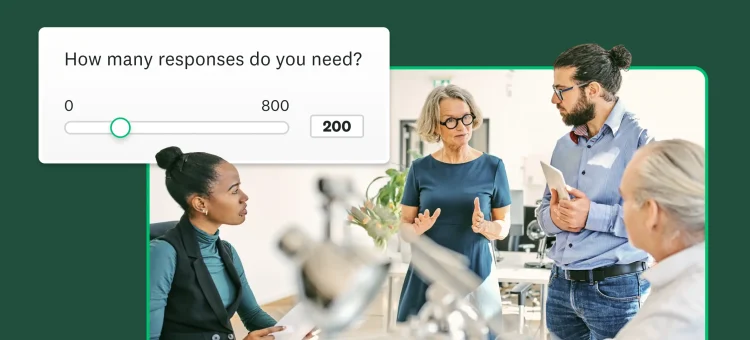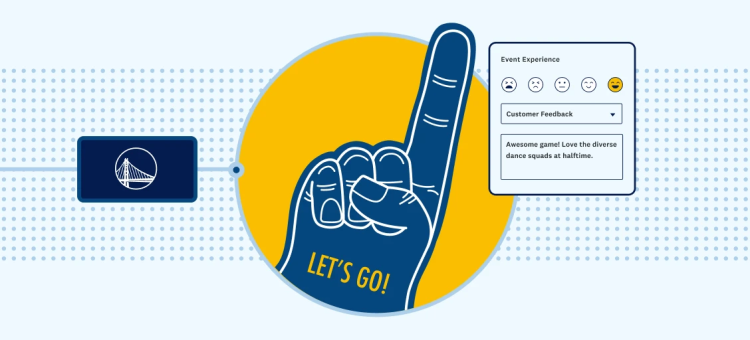As you look to run a research project, you’ll inevitably be tasked to determine a statistically significant sample size of respondents.
Worry not, we have an easy method for you to use in defining the appropriate sample size.
How to easily calculate your survey sample size
In technical terms, the question of how many responses you need for your survey to be valid goes straight to the concept of survey sample size (read all about it by following that link). For now, you’re OK knowing that there’s a certain number of survey respondents you need to ensure that your survey is big enough to be reliable or ‘statistically significant.’
To get to this number, use our sample size calculator or use the handy table below, which will help you understand the math behind the concept.
Market research you can get done today
Looking for a fast and easy market research solution? Meet our global consumer panel SurveyMonkey Audience.
The first steps in determining the sample size depends on the following factors:
1. Identify how many people are in your population
This is pretty simple. Your population is the total target audience or market whose views you’re interested in. It could be anything from the total U.S. adult population, to executive women between 25 and 35 years old who hold graduate degrees, to homeowners in the Minneapolis-Saint Paul metropolitan area.
2. Identify how representative your survey results need to be
This one is a bit trickier. The more straightforward way to look at it is, the closer your sample is in relation to the total population, the more representative your results are likely to be. Heck, if you surveyed every single homeowner in the Twin Cities you’d be pretty certain that your results represented the views of the whole home-owning population, right? But since it’s almost impossible to survey 100% of any particular population, the next best thing is a well-designed survey where you have an acceptable level of tolerance for inaccuracy.
Let’s have a look at the table to understand this last point. You’ll notice that if you allow for greater inaccuracy–or margin of error–the recommended sample size gets smaller. If you can live with a 10% margin of error, you only need 80 out of 500 people to respond, as opposed to 220 for a 5% margin or 345 for a 3% margin.
Respondents Needed at Error of ±3%, ±5%, and ±10%
| Population | ±3% | ±5% | ±10% |
| 500 | 345 | 220 | 80 |
| 1,000 | 525 | 285 | 90 |
| 3,000 | 810 | 350 | 100 |
| 5,000 | 910 | 370 | 100 |
| 10,000 | 1,000 | 385 | 100 |
| 100,000 | 1,100 | 400 | 100 |
| 1,000,000 | 1,100 | 400 | 100 |
| 10,000,000 | 1,100 | 400 | 100 |
The level of tolerance for inaccuracy will depend on your confidence in being able to make decisions based on the data you obtain, and of course in the importance of the decisions you’re making. Are you surveying your college class about where to hold the Alumni Happy Hour this year? Perhaps, you can afford to have a greater margin of error. On the other hand, if you are in charge of divvying up your company’s annual marketing budget, it’s best to keep the margin of error relatively low so that you can be confident that you’re making the best decisions for your team.
Running an AB test? Calculate the statistical significance of your results in seconds using our calculator!
Find a statistically valid survey response rate
Let’s say you want to find out how many people in your region of 10,000 inhabitants favor a longer school day for children. Let’s also assume that you’re willing to accept an error of plus or minus 10%.
You use a sample size of 100 people, as the table recommends, and find that 70% of your respondents are in favor of a longer school day. Given your 10% acceptable error rate, you can assume that if you’d asked every person in your region to take your survey, the actual proportion in favor of the longer school day would range from 60% to 80%.
But what if that range is too big? What if you need to be more precise? If this is the case, look to survey more people. For example, assuming a population size of 10,000, you can see that you would need 385 survey respondents for a 5% margin of error.
How many people should you invite to take your survey?
The table recommends the sample size you’ll need. But this means completed questionnaires: You need to get survey respondents–not just people you invited to take the survey–until you have enough to match that number.
For example, assume you need 100 respondents and you expect that 20% of the people invited will actually respond. You would then need to invite 500 people (100 respondents ÷ .20 response rate = 500 invitations).
Even if you don’t feel comfortable estimating your response rate, we recommend starting with a relatively high figure. Reason being, you can normally send the survey to additional recipients in the future if necessary.
More resources to find your sample size
Even if you don’t hold a Ph.D. in statistics, you now have a handy tool to estimate how many people you need to respond to your questionnaire and have a statistically significant data set.
We have a lot more knowledge for you. Read our pages to learn more about: sample size, our sample size calculator, and our margin of error calculator.
This way you’ll always know how many respondents you need to make decisions with confidence, whether it’s based on your marketing budget or–more importantly–the right bar for happy hour.
Ready to send out your survey? Wait! Here’s one final tool to make sure it’s perfect. Get the handy checklist, ‘5 must-dos to send you survey out with confidence.' Download it now →



